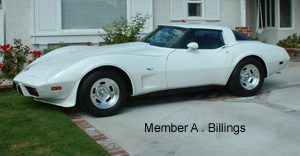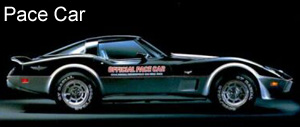
1978 was a big year for the Corvette. It was the 25th Anniversary of the Corvette. As well the Corvette was chosen to be the official pace car of the Indy 500. Chevrolet must have been one proud pappy of its sports car. For this reason in 1978 all Corvettes received special commemorative emblems. The complete production run were coupes.
The ten-year-old third generation body was subtly updated with a new fastback glass rear window roofline and a large wrap around backlight. The body in 1978 was widened in the rear fender area also. This detail was discovered by customizers when they were busy converting '78 and newer coupes to convertibles after the convertible production ended in 1975. Mechanically, a 220 hp higheroutput 350 cid V8 was available, though only with the automatic transmission. Your engine choices now were:
L-48 - 350 cu.in. 185 Hp
L-48 Calif. & High Altitude - 350 cu.in. 175 Hp
L-82 - 350 cu.in. 220 Hp
The engine could be mated with:
MX-1 Automatic, Turbo Hydra-matic 350
M-20 Manual, 4-spd, wide ratio
M-21 Manual, 4-spd, close ratio (Muncie)
You also had a choice of rear end ratios.
Acceleration times from magazines of that time gave 0-60 in 7.8 seconds for the L-48 with a top speed of 123 mph, while in a shoot-out on a test track in Ohio, the L-82 version was deemed "The Fastest Car in America" with a 134 mph top speed and a 0-60 time of 6.6 seconds.
But the big news for collectors and enthusiasts alike was the addition of two limited edition versions of the Corvette. The genuine Anniversary editions were those Corvettes ordered with the "25th Anniversary Paint" B2Z option. It was a distinctive two-tone silver paint treatment with a silver metallic upper body color and a charcoal silver lower body color. If you are considering a Anniversary Edition make sure you are not just buying a silver car that somebody has painted the lower body to resemble the real thing. Pin stripes accentuated the front upper profiles, wheel openings, front fender vents, hood, and rear license plate cavity. Optional aluminum wheels and dual sport mirrors were required before you could order the Anniversary package.

The second limited edition (and much sought after then and now) Corvette was the Pace Car Replica model, which commemorated Corvettes being used as pace cars in the 62nd Indy 500. The Pace Car Replica was decked out with a black upper body and silver-metallic lower body, plus The Silver Anniversary Year for Corvette the alloy wheels and fat Goodyear tires worn by the Silver Anniversary model (the same caution from above applies if purchasing a Pace Car as an investment). The Pace Car Replica also came equipped with front and rear spoilers as well. The identifying "Pace Car" decals were supplied separately so the owner could apply them if desired. The decals were a bit loud (in my humble opinion) and there are genuine Pace Cars with the decals still unused. Upholstery choices were either silver leather or a silver leather/ grey cloth combination. The seats were a new design scheduled to be introduced in 1979 Corvettes. Standard equipment included power windows, electric rear window defroster, air conditioning, sport mirrors, and other features which boosted the price of the Pace Car Replica over $4,000 more than the base Corvette. Because of its limited availability, new Pace Car Replicas fetched upwards of $28,000 (the suggested list price was only $13,653) almost immediately and a flood of fake Pace Car Replicas flooded the market - a situation that is similar today as then. The only clues to a real Pace Car Replica are the seats, which should resemble those of a 1979 Corvette and the serial number, which should be between 900001-906502.
While the 1978 Pace Cars and Silver Anniversaries captured most of the attention, Chevy managed to sell a lot of 'regular' Vettes (base price $9,352) too. Total production was 46,776, making the '78 one of the most popular Corvettes ever (the title goes to the 1979's). With the same options as the Silver Anniversary plus the availability of 10 paint and 8 interior colors, there was much to choose from. Of the production run for that year, 4,150 were painted classic white, 3,232 silver, 15,283 silver anniversary cars, 4,573 black, 6,502 black/silver Pace Cars, 1,960 light blue, 1,243 yellow, 1,686 light beige, 2,074 red, 2,121 mahogany, 2,084 dark blue and 1,991 dark brown. All, with the exception of Silver Anniversary and black/silver, came equipped with silver wheels. The Anniversary and black/silver Pace Car had mandatory alloys. A trivia fact (not substantiated) was that the reason the '78 Pace Car was decked out in black and silver was because it photographed well. Back then, most magazine articles and ads were still done in black and white.
The interior of the 1978 Corvettes also underwent a number of changes as well: The speedometer and the tachometer were redone and took on a more square profile. A glove box was put in. New inner side door panels with armrests were introduced. The washer controls were moved to the instrument panel. The 1978 Corvette's overall length is 185.2", with a width of 69", and a height of 48". It has a curb weight of 3,572 lbs. The wheelbase is 98". It rested on P225/70R by 15" tires on steel rims. Its front track is 58.7" and its rear track is 59.5". Unofficial records have the breakdown of cars produced as:
12,739 L-82's
12,590 Gymkhana cars
15,283 Silver Anniversary cars
6,502 Pace Cars
So what will it cost you to own this classic? Although the 'numbers matching' mania has finally begun to subside, correct, low-mile cars will always command the best prices. Thankfully the 1978 Corvette is not the kind of car the big money collectors are looking for, there are just too many of them. That gives the average buyer the chance to own a historically significant automobile that is affordable and yet has a stable value for years to come. I cannot stress strongly enough to watch out for bogus Anniversary and Pace Cars - there is the possibility that unscrupulous dealers or middlemen deceived even the original owners. I urge you to check numbers and consult with other club members who can tell the difference between the genuine article and a fake.
’78 VETTE FACTS
|
|
|
VEHICLE IDENTIFICATION NUMBER
|
1978 the numbers were Coupe 1Z87[ ]8S400001 to 1Z87 [ ]8S440274; Indy Pace Car 1Z87[ ]8S900001 to 1Z87[ ]8S906502. The first symbol 1 indicated Chevrolet. The second symbol identified the body series Z = Corvette. The third and fourth symbols indicated the body style number 87 = Coupe. The fifth symbol [in blank] indicates the engine: L=350-cid 175-hp or 185-hp V-8; H=350-cid 220-hp V8. The sixth symbol indicates the model year 8 = 1978. The seventh symbol identifies the assembly plant S = St. Louis. The last six symbols indicate the sequential production number.
|
|
ENGINE
|
BASE ENGINE
Type: V-8
Bore and stroke: 4.00 x 3.48 in.
Displacement: 350 cid
Brake hp: 185 at 4000 rpm.
Induction: Rochester
Type: V-8
Bore and stroke: 4.00 x 3.48 in.
Displacement: 350 cid
Brake hp: 175 at 4000 rpm
Induction: Rochester
California emissions and high-altitude
emsissions
OPTIONAL ENGINES:
350-cid/220-hp w/ Rochester
|
|
VITAL STATS
|
Coupe
Original Price: $9,351.89
Production: 40,274
Wheelbase: 98 in.
Length: 182.5 in.
Tires: P277/70R -15 steel-belted radial
Pace Car
Original Price: $13,653.21
Production: 6,502
Wheelbase: 98 in.
Length: 182.5 in.
Tires: P277/70R-15 steel-belted radial
|
|
COOL STUFF
|
• Corvette's 25th year.
• Glove box was added.
|